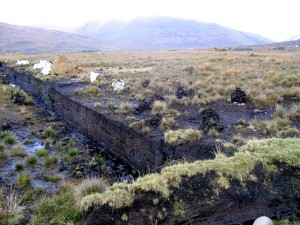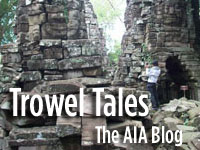The Poet and the Bog Body
by Heather Pringle
March 27, 2009
 As a journalist, I have written extensively over the years about all the science that goes into understanding vanished lives and extinct societies and civilizations. I have long been fascinated by the way archaeologists begin with the humblest of clues, say a dark-blue residue on a jagged sherd, and end up after years of scientific analysis with an entirely new glimpse into the lives of the Maya and the way in which they painted both people and jars a bright sky-blue before sacrificing them to their rain god Chaak.
As a journalist, I have written extensively over the years about all the science that goes into understanding vanished lives and extinct societies and civilizations. I have long been fascinated by the way archaeologists begin with the humblest of clues, say a dark-blue residue on a jagged sherd, and end up after years of scientific analysis with an entirely new glimpse into the lives of the Maya and the way in which they painted both people and jars a bright sky-blue before sacrificing them to their rain god Chaak.
By contrast, I have written very little over the years about the poetry of archaeology, and I now see that this is a glaring sin of omission, as we live in a privileged time. I say this because one of the finest poets in the English language today, Seamus Heaney, has written with great beauty and wonder about a particular group of the ancient dead: the Iron-Age bog bodies of Northern Europe.
If you have never heard of Seamus Heaney—the 1995 Nobel Laureate in Literature—I strongly encourage you to look him up the next time you are in a library or bookstore. Heaney spent the first 14 years of his life in the rural countryside of Northern Ireland, where his father owned a small cattle farm, Mossbawn. Nearly everyone in the region depended on peat for their winter fuel, and many farmers cut their own supplies. “When I was a child and an adolescent,†Heaney later recalled, “I lived among peat-diggers and I also worked in the peat bog myself. I loved the structure the peat bank revealed after the spade had worked its way through the surface of the peat. I loved the mystery and silence of the place when the work was done at the end of the day…â€
Heaney was equally fascinated as a child by the strange preservative powers of the bog. Many of the neighbors told stories about things they had found in the bog, and one local family recalled pulling the soft skeleton of an Irish elk from the tealike waters. To Heaney, the bogs of Ireland were a kind of memory-bank, both literally and figuratively, and he never forgot their power even after his family left Mossbawn and Heaney became an established poet in the Irish Republic.
We are all the luckier for this, for no one has ever written about the dead of Europe’s bogs as Seamus Heaney does. I’ll close this week by quoting from part of “ The Grauballe Manâ€:
As if he had been poured
in tar, he lies
on a pillow of turf
and seems to weep
the black river of himself.
The grain of his wrists
is like bog oak,
the ball of his heel
like a basalt egg.
His instep has shrunk
cold as a swan’s foot
or a wet swamp root.
His hips are the ridge
and purse of a mussel,
his spine an eel arrested
under a glisten of mud.
Those interested in reading more about the bog bodies and Seamus Heaney might like to check out the following essay and article, which appeared in Archaeology magazine:
Comments posted here do not represent the views or policies of the Archaeological Institute of America.






 Heather Pringle is a freelance science journalist who has been writing about archaeology for more than 20 years. She is the author of Master Plan: Himmler's Scholars and the Holocaust and The Mummy Congress: Science, Obsession, and the Everlasting Dead. For more about Heather, see our
Heather Pringle is a freelance science journalist who has been writing about archaeology for more than 20 years. She is the author of Master Plan: Himmler's Scholars and the Holocaust and The Mummy Congress: Science, Obsession, and the Everlasting Dead. For more about Heather, see our 

